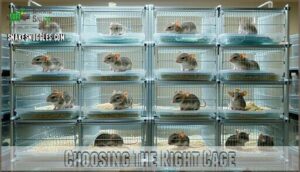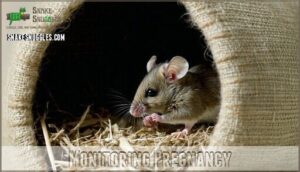This site is supported by our readers. We may earn a commission, at no cost to you, if you purchase through links.

You’ll need a proper breeding setup with temperature-controlled housing, quality bedding, and separate spaces for pregnant females. Start with healthy breeding pairs using a 1:2 male-to-female ratio.
Monitor pregnancies closely, as gestation lasts about 19-21 days. Once babies arrive, don’t disturb the nest for the first week.
Weaning happens around 3-4 weeks when pups can eat solid food independently. This self-sufficient approach beats constantly buying frozen feeders, but timing your breeding cycles requires strategy to match your snake’s feeding schedule perfectly, ensuring a steady supply of nutritious meals.
Table Of Contents
- Key Takeaways
- How to Breed Mice for Snakes?
- Setting Up Your Breeding Environment
- Selecting and Pairing Breeding Mice
- Caring for Pregnant and Nursing Mice
- Raising and Weaning Baby Mice
- Ethical Considerations and Humane Practices
- Frequently Asked Questions (FAQs)
- Can you breed mice for a snake?
- Can rats and mice be bred for snake food?
- Where can I buy live mice for a snake?
- How do I begin breeding rodents for snake food?
- How do you breed a rat for snake food?
- Why might you want to breed mice?
- Can I breed mice for my snake?
- How to breed mice quickly?
- Is mouse breeding profitable?
- How long does it take feeder mice to breed?
- Conclusion
Key Takeaways
- You’ll save 80% on feeding costs by breeding your own mice instead of buying frozen feeders, with proper setup requiring just a 12×24-inch cage, temperature control at 70-75°F, and quality bedding materials.
- Start with healthy breeding pairs using a 1:2 male-to-female ratio, ensuring all mice are 6-8 weeks old before breeding to maximize fertility and prevent complications.
- Monitor pregnancies closely during the 19-21 day gestation period, then avoid disturbing the nest for the first week after birth to prevent stress-induced cannibalism.
- Separate juveniles by gender at 3-4 weeks during weaning to prevent unwanted breeding, while maintaining ethical standards through proper housing, nutrition, and humane practices throughout the process.
How to Breed Mice for Snakes?
Breeding mice for snake food transforms your reptile care from expensive monthly purchases into a sustainable mouse colony.
You’ll establish healthy breeding pairs, maintain proper genetic diversity through record keeping, and cull unhealthy specimens.
This self-sufficient approach to raising mice guarantees fresh alternative feeders while controlling breeding frequency, ultimately providing consistent nutrition for your serpentine companions.
To prevent early breeding, it’s important to separate genders early, which is a crucial step in maintaining a healthy mouse colony.
Setting Up Your Breeding Environment
You’ll need to create the right conditions before your mice start breeding, which means getting your housing setup exactly right from day one.
Your breeding environment directly affects how quickly your mice reproduce and how healthy their offspring will be, so don’t skip the prep work that makes all the difference, as it is crucial for the breeding environment.
Success starts before the first litter—your setup determines everything that follows.
Choosing The Right Cage
You’ll want to pick a cage that’s built for success. Choose plastic-bottomed wire cages or glass aquariums measuring at least 12" wide by 24" long by 10" high for proper mice housing.
Make certain your mouse cage has excellent ventilation and easy cleaning access. Wire tops work best for airflow, while solid materials prevent chewing damage during your mouse breeding setup.
Many breeders prefer durable wire cages for their longevity.
Proper Temperature and Humidity
Your breeding mice thrive in Optimal Ranges of 70-75°F with 40-60% humidity.
Temperature Monitoring prevents sterility from extreme heat or cold.
Humidity Impact affects Respiratory Health—too much moisture causes breathing problems and odor buildup.
Seasonal Adjustments help maintain consistent conditions year-round.
Mice can still breed in colder temperatures if you provide localized heat sources.
Proper climate control guarantees healthy snake food production and successful mouse breeding cycles.
Bedding and Nesting Materials
Your mouse breeding guide starts with smart bedding choices.
Use dust-free materials like Auboise or paper-based options for Material Safety and Odor Control.
Keep Dust Levels minimal to prevent respiratory issues.
Provide Nesting Variety with cardboard tubes, plastic hideouts, and soft nesting material.
Creating escape-proof enclosures is vital for breeding snakes.
Focus Cost Effectiveness by choosing reusable options.
Quality bedding guarantees healthy breeding mice for reliable snake food production.
Selecting and Pairing Breeding Mice
You’ll need to choose healthy mice without any signs of illness and pair them correctly to guarantee successful breeding for your snake’s food supply.
The key is maintaining a ratio of one male to two females per cage while making sure your mice are at least 6-8 weeks old before they start breeding.
Choosing Healthy Mice
Three key factors determine successful breeding pairs.
First, examine each mouse’s physical health—bright eyes, smooth coat, and active behavior indicate good disease resistance.
Second, prioritize genetic diversity by selecting different mouse strains to prevent inbreeding.
Finally, choose mice between 6-8 weeks old for maximum fertility.
Temperament screening guarantees calm breeding mice that won’t stress during mating.
Optimal Male-to-Female Ratio
Once you’ve selected healthy mice, getting the male-to-female ratio right makes all the difference in breeding efficiency. One male paired with two females creates the sweet spot for consistent litter production while maintaining genetic diversity.
This setup prevents overworking your females and guarantees sustainable breeding for snakes. Success has also been reported with higher ratios, but population density matters.
- Maximizes breeding efficiency without stressing females
- Maintains genetic diversity across multiple litters
- Balances resource allocation between breeding pairs
- Supports prime female health and litter size
Introducing Breeding Pairs
When bringing together your breeding pairs, create a stress-free introduction by placing one male with two females in a spacious cage.
Monitor aggression closely during the first few days, watching for compatibility signs like peaceful coexistence.
Make certain both mice have reached breeding age (6-8 weeks) and maintain genetic diversity by avoiding related pairs for successful mouse mating.
Caring for Pregnant and Nursing Mice
Once your breeding pairs have mated successfully, you’ll need to provide specialized care to guarantee healthy pregnancies and strong litters.
Pregnant and nursing mice require enhanced nutrition, careful monitoring, and a stress-free environment to produce the quality feeders your snakes need.
Nutritional Requirements
Once you’ve paired your breeding mice successfully, proper nutrition becomes your foundation for healthy offspring.
Your breeding success starts with premium nutrition—healthy mothers produce the quality feeders your snakes deserve.
Feed pregnant and nursing females a diet rich in protein sources and nutritious meals that’ll benefit your snake’s diet later.
- Provide high-quality rodent pellets with constant water access through bottles
- Add dietary supplements like scrambled eggs and cooked meat for nursing mothers
To further support breeding, consider specialized mouse supplements.
- Prevent obesity by monitoring portions while ensuring adequate nutrition for reptile food quality
Monitoring Pregnancy
Once you’ve optimized nutrition, monitoring pregnancies becomes your next focus. Watch for pregnancy signs like weight changes and nest building behavior during the gestation timeline of 19-21 days. Plug observation helps confirm mating success, though it doesn’t guarantee pregnancy.
| Week | Physical Changes | Behavioral Signs |
|---|---|---|
| 1 | Minimal weight gain | Increased appetite, less active |
| 2 | Noticeable belly rounding | Nest building intensifies |
| 3 | Significant weight increase | Territorial, seeks quiet spots |
| 4 | Prominent swelling | Restless, prepares birthing area |
| Birth | Visible contractions | Isolates from other mice |
Female behavior shifts dramatically as pregnant mice become more protective and territorial. Some mothers show obvious swelling while others remain subtle until delivery.
To identify potential problems, research early pregnancy indicators online. Monitor pregnancies daily without disturbing the nesting area unnecessarily.
Post-Birth Care
Your mouse mother’s instincts usually kick in perfectly, but you’ll need to monitor the litter care closely.
Leave the family undisturbed for 24 hours after birth to prevent stress-induced cannibalism prevention issues.
Key post-birth priorities include:
- Nesting comfort – Provide coiled wood materials for warmth
- Growth monitoring – Check baby mice daily for proper development
- Weaning food – Introduce softened pellets at 3-4 weeks for smooth pup separation
Raising and Weaning Baby Mice
Once your baby mice are born, you’ll need to monitor their growth carefully.
This stage requires patience and attention to detail, as proper weaning guarantees healthy mice that’ll provide superior nutrition for your snakes, and it starts at around three to four weeks old with the weaning process.
Growth Milestones
The first week brings dramatic changes in your baby mice.
Weight gain accelerates rapidly while fur development creates their signature coat.
Eye opening occurs around day 10-14, marking a pivotal milestone.
You’ll observe improved motor skills as they become more coordinated.
Social behavior emerges when siblings start interacting, signaling healthy development in your mouse breeding program.
Weaning Process
Once your pups hit the three-week mark, you’ll begin the weaning process that sets them up for independence.
This mouse development milestone requires careful litter management and strategic feeding schedule adjustments.
Here’s your step-by-step approach to successful mouse weaning:
- Introduce softened pellet food alongside continued nursing access
- Provide shallow water dishes they can easily reach
- Monitor each pup’s eating habits and weight gain daily
- Gradually reduce mother’s presence over one week
Weaning tips include watching for strong appetites and steady growth during this critical pup care phase.
Separating Juveniles
Once your young mice hit the weaning milestone, you’ll need to tackle juvenile care through proper sex separation. This critical mouse breeding process step prevents unwanted pregnancies and fights.
| Age | Housing Setup | Key Actions |
|---|---|---|
| 3-4 weeks | Initial separation | Begin mouse weaning process |
| 8-12 weeks | Separate cages by gender | Complete litter management |
| Adult | Breeding or feeding groups | Maintain cage division system |
| Replacement | New breeding stock | Select healthy juveniles |
Separate males and females into different cages immediately after weaning. Keep siblings together when possible, as they’ll get along better. Use proper cage division to house trios comfortably while maintaining weaning tips for future success.
Proper handling and storage techniques, including safe thawing methods, are essential for maintaining the health and quality of the mice.
Ethical Considerations and Humane Practices
You’re responsible for treating your breeding mice with respect and care throughout their lives, from birth to their role as food for your snake.
Proper housing, adequate nutrition, and humane euthanasia methods aren’t just ethical requirements—they’re essential practices that guarantee healthier prey and better outcomes for your snake’s wellbeing, which is crucial for the snake’s wellbeing.
Proper Feeding and Housing
Beyond successful weaning comes the foundation of ethical mouse breeding: proper care standards. Your breeding operation’s reputation hinges on providing quality housing and nutrition that keeps mice healthy and stress-free.
Cage Design should prioritize space and comfort. Water Supply must remain constant through reliable bottle systems. Food Quality directly impacts your mice’s health and reproductive success.
- Mouse housing options include wire-top cages, glass aquariums, or ventilated storage containers
- Ventilation Systems prevent ammonia buildup and respiratory issues through adequate airflow
- Bedding Materials like paper pellets or wood shavings create comfortable, absorbent substrate layers
Preventing Overcrowding
Cage Size matters when managing your breeding colony. Keep no more than 8-10 adult mice per standard enclosure to prevent stress and fighting.
Separate juveniles by 4 weeks to control Population Management and avoid unwanted litters.
Monitor Mouse Limits closely—overcrowded conditions lead to cannibalism and disease. Smart Space Optimization keeps your Breeding Control system running smoothly.
Humane Euthanasia Methods
You’ll face tough decisions when managing your mouse colony.
Humane euthanasia requires proper technique and equipment to minimize suffering. The most ethical approaches guarantee quick, painless death.
- CO2 euthanasia – Fill chamber slowly, allowing gradual unconsciousness before death
- Cervical dislocation – Swift neck separation requiring proper training and technique
- Blunt force – Only acceptable for newborns under six days old
Frequently Asked Questions (FAQs)
Can you breed mice for a snake?
Breeding mice costs 80% less than buying frozen feeders long-term.
You’ll need mature mice (6-8 weeks old), proper housing with ventilation, and patience.
Pair one male with two females, maintain 72°F temperature, and expect babies in 19-21 days.
Can rats and mice be bred for snake food?
Yes, you can breed both rats and mice for snake food. They’re excellent feeder options with similar breeding requirements. Mice reproduce faster, while rats provide larger meals for bigger snakes.
Where can I buy live mice for a snake?
You can purchase live mice from local reptile specialty stores, pet shops, or online suppliers like RodentPro. Many reptile expos also sell feeders. Call ahead to confirm availability and sizes.
How do I begin breeding rodents for snake food?
Start with healthy mice from pet stores – one male per two females in a 12×24-inch cage.
Maintain 72°F temperature, provide pellet food and water constantly, then wait for nature to work its magic.
How do you breed a rat for snake food?
Many believe rat breeding requires complex setups, but it’s surprisingly straightforward.
You’ll pair one male with one female, separate after mating, then wait 20-29 days.
Feed her extra food post-birth and separate babies at four weeks, which is a straightforward process.
Why might you want to breed mice?
Breeding mice saves money compared to buying frozen feeders, guarantees fresh quality food for your snake, and gives you complete control over your pet’s diet and feeding schedule year-round.
Can I breed mice for my snake?
Yes, you can absolutely breed mice for your snake! It’s cost-effective and guarantees fresh, healthy prey. You’ll need proper housing, breeding pairs, and patience for the 19-21 day gestation period.
How to breed mice quickly?
Coincidentally, faster breeding happens when you pair one male with two females at 6-8 weeks old.
They’ll mate every 3-4 days, producing litters in just 19-21 days with proper warmth and nutrition.
They will require these conditions to be met consistently for optimal results.
Is mouse breeding profitable?
You’ll likely break even rather than profit from mouse breeding.
Feed costs, housing supplies, and time investment typically offset savings from buying mice.
Small-scale operations rarely generate significant income compared to commercial breeders.
How long does it take feeder mice to breed?
Mice reach sexual maturity at 6-8 weeks old.
Then gestation takes 19-21 days.
You’ll have baby mice ready to wean at 3-4 weeks after birth, totaling roughly 10-13 weeks from start to harvestable feeders.
Conclusion
Successfully establishing your own feeder colony transforms snake ownership from expensive to economical.
Learning how to breed mice for snakes requires patience, dedication, and proper planning, but the rewards justify the effort.
You’ll provide fresher nutrition while saving significant money long-term.
Remember to maintain ethical standards throughout the process, ensuring both your breeding stock and snakes receive proper care.
With consistent monitoring and appropriate housing conditions, you’ll master this essential reptile-keeping skill and achieve feeding independence.















